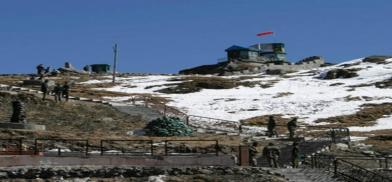Is China eyeing more territory in India and Bhutan?
The visit by the Indian Army chief to Bhutan in the backdrop of China’s territorial advances in Bhutan and India have brought into focus China’s future intentions, writes Lt Gen P. C. Katoch (retd) for South Asia Monitor

It would be wrong to say that China’s all-round aggression is not buoyed by America’s inability to engage Russia directly in Ukraine, plus the fallout of the Ukraine conflict on the US and Europe, even though the Biden Administration is not bothered how it affects the balance of the world.
Proof of this was the Chinese President bluntly telling the Joe Biden on July 28 that both sides of the Taiwan Straits belong to China, China will not allow Taiwan independence, brook no outside interference in this issue and those who play with fire will perish in it.
The US has been forced to cancel the visit of Nancy Pelosi, Speaker of the House of Representatives, to Taiwan.
Indian Army chief in Bhutan
General Manoj Pandey, Chief of the Indian Army, recently made a two-day official visit to Bhutan. He called on King Jigme Khesar Namgyal Wangchuk and held extensive discussions with his Bhutanese counterpart Lt Gen Batoo Tshering to further the bilateral relationship.
The situation in the Doklam tri-junction area and Chinese encroachments in Bhutan would have been the likely main focus of discussion. Pandey also met other civil and military officials of Bhutan.
India has permitted export of 5,000 tonnes of wheat and 10,000 tonnes of sugar to Bhutan to meet Thimpu’s immediate requirements.
Recent satellite images show a fully developed Chinese village east of Doklam on the Bhutanese side, about nine km from the Doklam tri-junction. The village has cars parked alongside almost every house and the village has an all-weather carriageway, which could give China access to Bhutan’s Jhampari Ridge. PLA occupation of the Jhampari Ridge would outflank Indian defences in Sikkim bordering Bhutan. Jhampari Ridge would also bring the crucial Siliguri Corridor within the PLA's long range weaponry.
Earlier, in November 2018, China built the village ‘Pangda’ just inside the southwestern border of Bhutan. In 2019, China constructed the village ‘Gyalaphug’ two kilometers inside Bhutan with a new road leading to it; about nine kilometers from the India-China 2017 standoff in Doklam Plateau. Concurrently, another report has revealed that some other areas of Western Bhutan have also been gradually encroached by China.
Secure China
China is sitting pretty because Bhutan never acknowledged the loss of territory to China’s illegal encroachments, same as what has happened in Nepal.
India also did not blame China for having established a village at Lonju in Arunachal Pradesh. Now, the PLA is recruiting Hindi speaking Tibetans and Nepalese for its frontline cantonments and border villages.
In 2020, China laid claim to the Sakteng Wildlife Sanctuary in Eastern Bhutan which borders Arunachal Pradesh. The northern end of this sanctuary does not border China-occupied Tibet but China is perhaps planning to open a route to it from the north or through Arunachal Pradesh by nibbling more Indian territory. Bhutan did protest Chinese claim to the Sakteng Wildlife Sanctuary but Beijing is adamant it is Chinese territory.
The 16th round of military-to-military talks between India and China over the standoff in Eastern Ladakh was held on July 17, 2022. As expected, China has refused to budge, as was the case in the previous two rounds of talks. While the Indian policy makers are looking for more rounds of talks to deflect from the Chinese intrusions made during 2020, China has been unambiguously signalling a status quo.
PLA build-up
The PLA has used these talks to consolidate its defences in these intrusion areas and improve its offensive posture. The PLA has been holding military exercises using attack helicopters over Pangong Tso as well as in the area of Lake Mansarovar. China stopped giving visas to pilgrims from India for the Kailash-Mansarovar Yatra since its 2020 aggression in Ladakh. Now China is periodically flying fighter jets close to the Line of Actual Control (LAC) in violation of the bilateral agreement not to do so within a 10-km zone.
For those who think that China would be content with the territory it has grabbed in Ladakh, China has recently released plans to construct a second highway (G695 national expressway) through Aksai Chin along the border with India. This expressway is planned to be completed by 2035, but going by the speed with which China develops border infrastructure, it could be completed even earlier.
According to the South China Morning Post, the alignment of this expressway, though unclear, may also go near the Depsang Plains, Galwan Valley and Hot Springs on the LAC. Would the new road China had constructed five km short of Galwan to facilitate its 2020 aggression become part of the G695 national expressway?
One of the reasons for China to capture Aksai Chin was to give depth to its Western Highway. How will China provide depth to its G695 national expressway running along the LAC with India in Ladakh, given that China has already shifted it westward in 2020? This should be of serious concern to India, even though the civil and military leaders may change by then.
(The author is an Indian Army veteran. Views are personal.)










Post a Comment